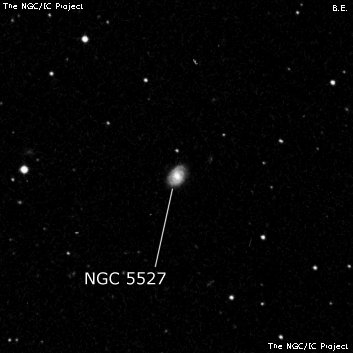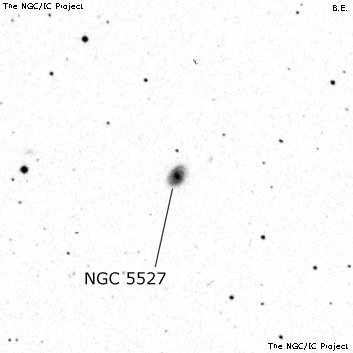NGC/IC Project Restoration Effort
(This is a very very beta version)
NGC5527


Basic Information
Location and Magnitude
Right Ascension: 14:14:27.2
Declination: +36:24:16
Constellation: BOO
Visual Magnitude: 13.8
Historic Information
Discoverer: Mitchell
Year of discovery: 1855
Discovery aperture: 72.0
Observational
Summary description: eeF
Sub-type: Sbc
Corwin's Notes
=====
NGC 5527 is probably the object called "NGC 5524" by virtually everybody.
Found R.J. Mitchell, LdR's observer on 19 April 1855, it has just one
observation recorded under the entry for NGC 5529. That observation reads,
"h. 1764 [NGC 5529], long narrow ray with a S, R, vF neb sf; another vF about
15' np 1764; and another eeF about 6' p and 1' n of this last." Dreyer adds
the note, "The positions given in the G.C. for 2 R. novae, [GC] 3819 [= N5524]
and [GC] 3821 [= N5527], are not in accordance with this."
In the observation, it's clear that Mitchell found four nebulae in the field.
One of these, the "S, R, vF neb sf" is neither in GC nor NGC (it is CGCG
191-071, one of several nebulae known to Dreyer that he did not include in
NGC; see "notngc" files for more on this object). The other three nebulae,
N5524, N5527, and N5529 are arranged along a curve according to Mitchell's
description. It is also clear that the new objects can have only approximate
positions as Mitchell did not measure micrometric positions for them at Birr
Castle.
An additional problem concerns the adopted positions and descriptions. The
positions are by JH for GC and, as Dreyer noted, do not correspond with the
description given by Mitchell. Dreyer switched the positions for NGC, but
still got Mitchell's descriptions of brightness reversed -- the faintest
object is clearly the western-most of the objects, i.e. NGC 5524.
Given all this, it is reasonable to suppose that the brightest object
northwest of NGC 5529 is NGC 5527, and that a still fainter object is west-
northwest of it. This makes N5527 = CGCG 191-067 (it is 17.2 arcmin from
N5529), but leaves the position for NGC 5524 vacant (there is a star nearby
that I now -- November 2014 -- take to be NGC 5524; more below). The object
was taken to be a star by Carlson, and was noted in MCG as "Not found." But
both Carlson and VV put their "identifications" on NGC 5527, and based their
comments on the NGC positions. As I noted above, these positions have
problems that make them essentially unuseable.
Other possibilities for NGC 5524 include a very faint galaxy in the right
direction from N5527 that Mitchell might have seen, but it is almost 13
arcminutes away, not 6+ arcminutes as in the observation. There is also a
somewhat brighter triple star on to the northwest of N5527 (14 11 42.2,
+36 43 48; B1950.0, mean of the three DSS positions), but it is 9.5 arcmin
from the galaxy, and is probably too bright to be called "eeF." The stars
are also pretty well separated: the northern star is 30 arcsec away from the
southern.
Another possibility, the one I previously adopted, is the double star 7.9
arcmin west-southwest of N5527. This is a reasonable choice if Mitchell's
description were changed to read "... another eeF about 6' p and 1' s ..."
The second star of this pair is much fainter than the brighter, but may have
added just a hint of nebulosity to the object. While this identity may be a
(reasonable) guess, it suggests that Mitchell's description is wrong by
assuming that he confused south for north.
-----
Looking at this again in November 2014, I'm unhappy about that, and have
instead opted for the faint star now given in the table with a single colon.
This has the advantage of being just 5.5 arcmin from NGC 5527, and north of it
by just under an arcminute, consistent with Mitchell's estimate, if not his
direction.
Finally, note that the object called "NGC 5524" by Bigourdan is actually NGC
5527 (he notes "NGC 5527" as "Non vue" on two nights). Dreyer included
Bigourdan's RA in the IC2 notes as a correction to the position of NGC 5524,
though the "correction" applies to the wrong galaxy.
Steve's Notes
=====
NGC 5527
18" (7/2/11): fairly faint, fairly small, round, 35" diameter, weak even concentration but no core or zones. Located 17' NW of the thin edge-on NGC 5529. This galaxy is misidentified as NGC 5524 in most sources.
17.5" (5/27/95): very faint, small, round, 30" diameter. No concentration although appears asymmetric and possibly brighter on the west side (or an extremely faint star superimposed). Located 17' NW of NGC 5529. This galaxy is identified as NGC 5524 in modern catalogues.



